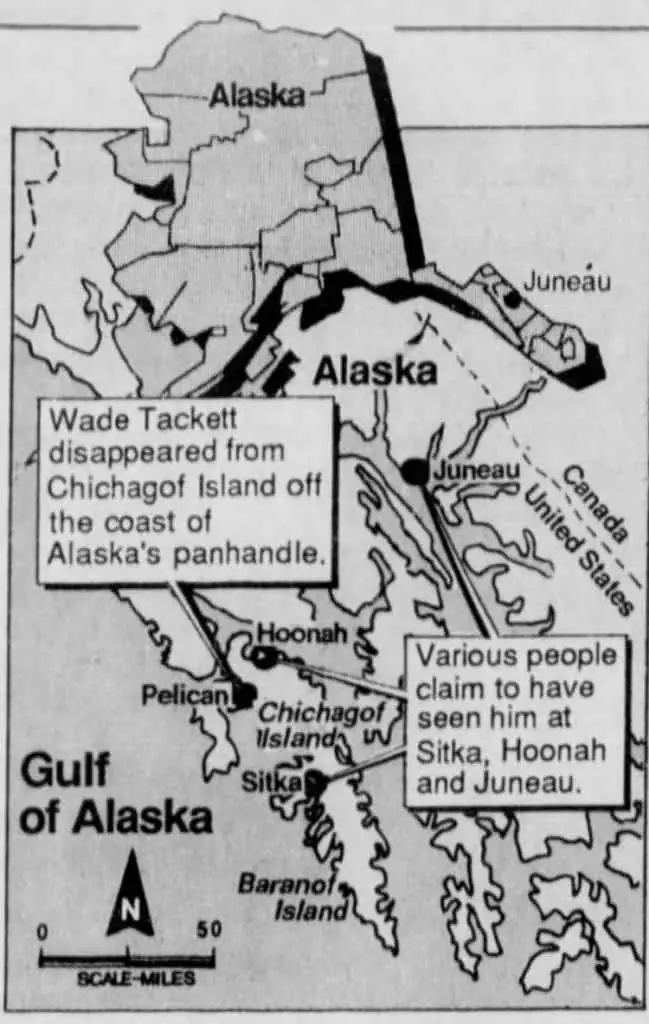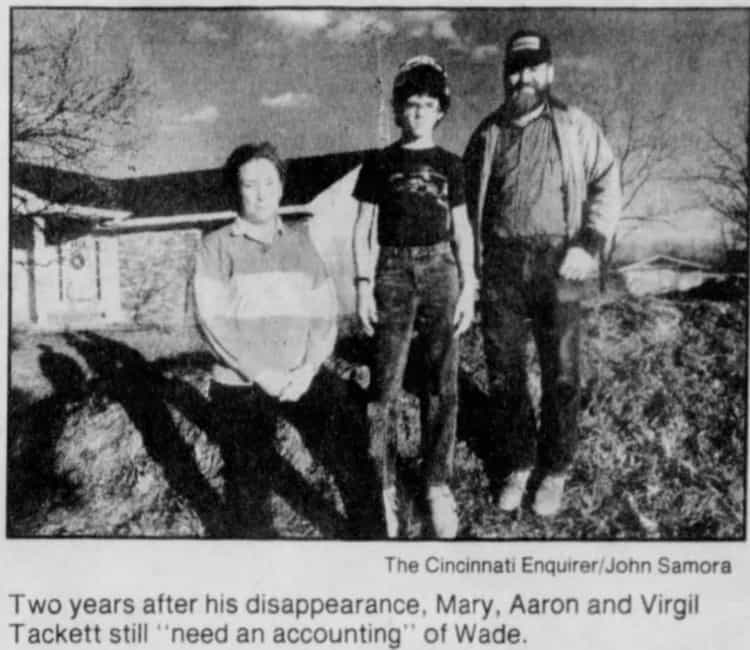PELICAN, Alaska — Virgil Wade Tackett was a good kid who loved the outdoors and religion. He was a devout Mormon and followed its strict healthy lifestyle — no alcohol, tobacco, or caffeine — and read scripture daily.
Wade spent the summer of 1985 working in Hawaii and returned to Ohio with $1,300 – $1,000 paid back his travel loan. His family hardly recognized him, with his sun-bleached hair and tanned, muscular body.
The following May, Wade flew to Pelican to spend the summer working in the fishing industry. Three weeks into his trip, he vanished without a trace, never to be seen again.

Where’s Wade?
On June 11, 1986, Wade, 17, and his friend, Nick Bevans, 16, explored the abandoned gold stamp mill on Chichagof Island. Then the boys climbed into a borrowed 14-foot skiff and cruised to Junction Island for a picnic lunch.
According to the police report, Nick told investigators after the two boys ate, Wade said he wanted to explore solo. “I am going to see how big that (blank) is,” Wade said. The Cincinnati Enquirer, which heavily covered the disappearance, reported that the police did not explain the blank space.
Nick said Wade jumped into the skiff and sailed away. He heard the boat circumnavigate the island for roughly an hour, but Wade never returned. Nick flagged down a fisherman, and the two located the skiff stuck on a sandbar of another nearby island. He said the 25-horsepower outboard’s motor was still in gear, and someone had tossed a tie-up line inside.
Nick noticed a high-powered rifle in the boat, but police never checked to see if anyone had fired the gun. The boat’s radio and life jackets were untouched.
Searchers later located one of two new bright yellow oars on the second day of the search but never found the other.
Search and Investigation
The police launched a search for Wade Tackett using commercial boats, a Coast Guard helicopter, and a patrol vessel. But a half-day later, authorities suspended the search. Even though they had no idea how or why he fell off the skiff and into the 40-degree water, the police believed Wade Tackett drowned in the Gulf of Alaska.
Authorities speculated Wade was standing up while operating the skiff. They also thought his hat might have blown into the water, and he used the oar to retrieve it but accidentally fell into the water. Such speculation seemed a bit rushed to Wade’s family, who never thought he drowned.
The police closed the case two weeks later and never wavered from their belief that Wade Tackett had drowned and his body might never be recovered.
Parents Refuse to Give Up
Virgil and Mary Tackett were sound asleep back in Ohio when a family friend, the father-in-law of Wade’s boss in Alaska, knocked on their front door at 3 a.m. on June 12, 1986, and told them their son was missing.
The Tacketts hopped on a 12-hour flight to Alaska to look for Wade. They wondered if their son somehow hurt himself and might not have known who he was.
Upon arriving in Pelican, the parents located the skiff and found three dead seals nearby and the zipper pull to Wade’s nylon vest in the bottom of the boat. Authorities could not explain how it had gotten there. The Tacketts also visited Junction Island, where Wade and Nick had eaten lunch and found the top of a metal potato chip can.
Mary Tackett could not wrap her head around the police’s theory that Wade might have been standing up while operating the skiff and that he did not wear a life jacket. Their son believed in safety first and foremost; he would not have done either.
The Tacketts were also cautious of Nick Bevans’s story. Wade was three merit badges short of Eagle Scout and knew the importance of a buddy system. He would never have left his friend alone. Nothing made sense.
Despite several attempts to convince the police their son might be alive, authorities insisted Wade had drowned.
But the Tacketts were not going to give up.
Sightings
Virgil Tackett’s third trip to Alaska resulted from a call from a psychic. Frances Cannon, known as the “Singing Psychic,” sensed that Wade Tackett was alive and in Sitka.
Virgil, his friend, Ron Molen, and Frances Cannon immediately flew to the Land of the Midnight sun and rented a car. The trip lasted 10 days, and quite a bit happened along the way.
Several people reported seeing Wade at various locations throughout Chichagof Island. A fishing captain said Wade approached him about a job. Another claimed to have seen him twice, although the boy had longer hair than in the picture on missing flyers. A third man said he had spotted Wade at Sitka Airport a few days before. All of them said the boy seemed “confused.” Other possible sightings of Wade were at ANB Harbor or the Sitka Hotel.
With a potential last name of Donapher, a woman named Mimi was a medicine woman for a tribe related to the Athabaksins. She told Virgil that Wade was “well taken care of, trained in Indian ways, and healed of some disorder.” She made it clear he would not be released for several years.

Local Help
During the first week of March 1987, Mary telephoned Delores “Dolly” Whaley, founder and CEO of Missing Children of America. Mary told her that Virgil had made another trip to Alaska and asked if Dolly had any news on Wade that she could provide to Virgil.
Dolly had no idea who Wade Tackett was because he was not in her files, but she wrote down the boy’s name and the Sitka Airport’s phone number. It soon dawned on her that Wade was the subject of a few mysterious phone calls she had received months earlier.
The calls took place between October 1986 and January 1987. The unidentified callers told Dolly that Wade was ill and being “well taken care of.” One woman bore the accent of a Tlingit Indian.
Dolly tracked down Virgil at the airport and told him about the mysterious phone calls. She also informed him that if Wade was alive, she could get a 48-hour psychiatric hold on him. Since Wade was now 18 years old, the police could not pick him up. Two days later, after visiting a doctor and a judge, Virgil filed the required paperwork.
Meanwhile, a local woman had contacted Mary through Sitka’s Church of Jesus Christ of Latter-Day Saints. The woman, a local hairstylist, said she was 100% sure she had cut Wade’s hair in late December 1986. Mary asked about facial features and hair color. By the time the phone call ended, the woman had convinced Mary that it was Wade.
However, the Tacketts ran into one big obstacle: police disregarded their son’s sightings as fabrications or cases of mistaken identity and did not follow up on the leads.
Congressional Aid

Photo by Gage Skidmore
Virgil and Mary Tackett, and many of their friends, flooded U.S. Rep. Bob McEwens’ office with letters urging him to use his influence in Wade’s disappearance.
McEwen was a sponsor of 1984 legislation that created the National Center for Missing and Exploited Children and knew how vital it was for swift action by police after a child goes missing.
But McEwen had run into the same obstacles as the Tacketts. He received a letter from the Juneau commander of the Alaska State Troopers, maintaining Wade had drowned.
McEwen’s staff continued to pressure the police for action, and the family begged the FBI to get involved by sending letters and petitions to the agency. The Tacketts even traveled to the nation’s capital during fall 1987 to speak with agents, but the FBI did not get involved in Wade’s disappearance.
Another Phone Call, More Heartache
On Saturday, April 25, 1987, Dolly Whaley received a telephone call from two Indians speaking through an interpreter. They thought they had seen Wade Tackett at an Alcoholics Anonymous meeting in Hoonah, another tiny village within the Alexander Archipelago. Their description of Wade was consistent with the other sightings.
Wade was not a drinker, but the tip seemed solid. Dolly took down personal information from the callers and informed the local police, who later told her the lead was a bust and provided no further explanation.
Dolly believed that Wade Tackett was alive but did not remember who he was. She was a former Indian agent and knew that some Indian villages were remote. “If they found him wandering aimlessly, they might have taken him in and adopted him,” Dolly said. She had intended to investigate further, but it is unclear whether she did.
Talk Show Tip
The Tacketts had spent nearly $20,000 on finding their son and decided to go on with their lives by returning to work and raising Wade’s younger brother, Aaron.
In 1989, a producer from the “Oprah Winfrey Show” called and asked the Tacketts to appear on a segment about missing children; they agreed.
Lynn Brooks resided in Yellowknife, the capital city of Canada’s Northwest Territories. She had watched the show and contacted Wade’s parents after it aired. A few months before, she ran into a group of young men at a local bar and had a three-hour conversation with one of them.
“He was different, very quiet, much younger, kind of lost,” she said. “He nursed the same beer all evening.”
The man told Lynn his name was Wayne; he was from Michigan and loved wildlife. She believed Wayne was Wade Tackett. The sighting was similar to the Sitka hotel sighting in 1987.
Work crews were typical in the Northwest Territories. They drifted from one remote town to another and were paid in cash, without the requirement for valid identification. Once the workers left an area, they were nearly impossible to track. Four thousand missing person flyers were printed in English and French and distributed at border crossings. (Warrick, 1987)
The Charley Project reported Wade might have been seen in March 1998, on Montreal Street and Charles Street in Kingston, Ontario.
Aftermath
Wade Tackett has never been found. His mother, Mary, died on March 5, 2010. She was 72 years old. The family did not mention Wade in her obituary. Virgil and Aaron Tackett still reside in Ohio.
Dolly Whaley passed away on March 8, 2008, at the age of 80. Her obituary states on Find a Grave, “She was instrumental in reuniting many lost children with their parents and guardians. Her efforts earned her many awards, including commendations from the governor of Alaska, a service-oriented sorority, and national exposure in Ladies Home Journal.”
Author R.W. Swartz has written a book on Wade’s disappearance. “Cool Water, Cold Hearts” is due for release in March 2021. You can find many pictures of Wade Tackett on his website.
True Crime Diva’s Thoughts
I’m with the parents on this one; I don’t believe Wade drowned. There were way too many sightings of him for me even to consider that possibility. Granted, the sightings have not been confirmed, mostly because the local authorities were lazy, at best, with the investigation.
I believe that Nick Bevans lied about that day’s events, and he might have hurt Wade. What reason did Wade have to explore alone? He went there with Bevans, so that does not make sense to me. I’m not sure I believe anything he said.
I also think the police covered up the disappearance for whatever reason. They always insisted he drowned despite no evidence supporting this theory. If he had drowned, how did the boat end up on a sandbar? Did anyone actually see Nick and Wade together in the skiff at any point that day?
If it was not Wade sighted in various locations, then who was it? What about the Sitka Hotel and Canada sightings? If it was Wade, did he forget who he was, or did he intentionally leave Alaska to start a new life elsewhere? I can’t imagine he would stop communicating with his family.
And what about Wade being taken care of by the natives? What was wrong with him, and why could they not release him for several years? This scenario does not make sense either.
LE did not investigate shit with this case, and they certainly did not want anyone else to do it either. WHY?
Primary source: Cincinnati Enquirer via Newspapers.com: Five-part series written by Camilla Warrick, December 27, 1987, to December 31, 1987.




